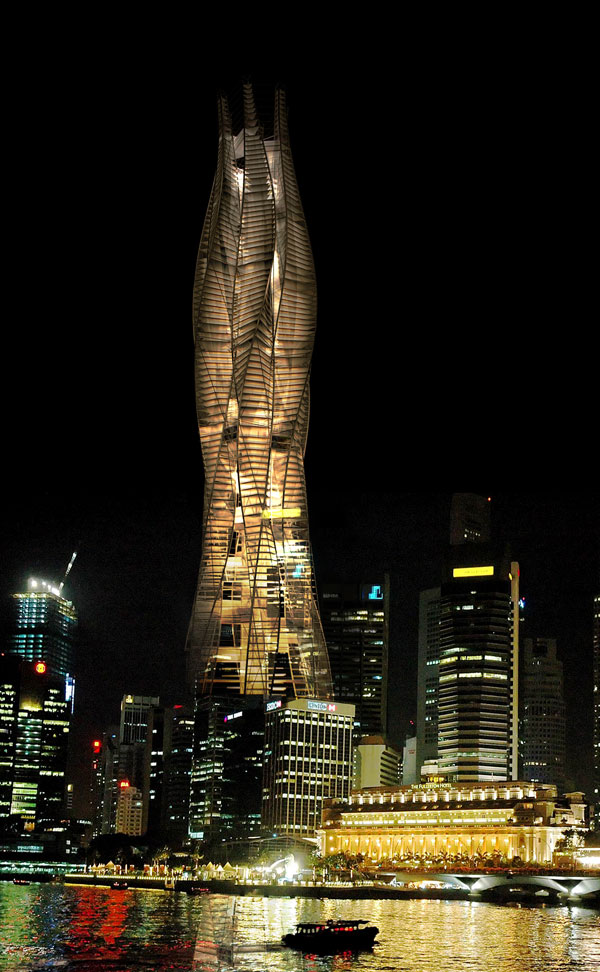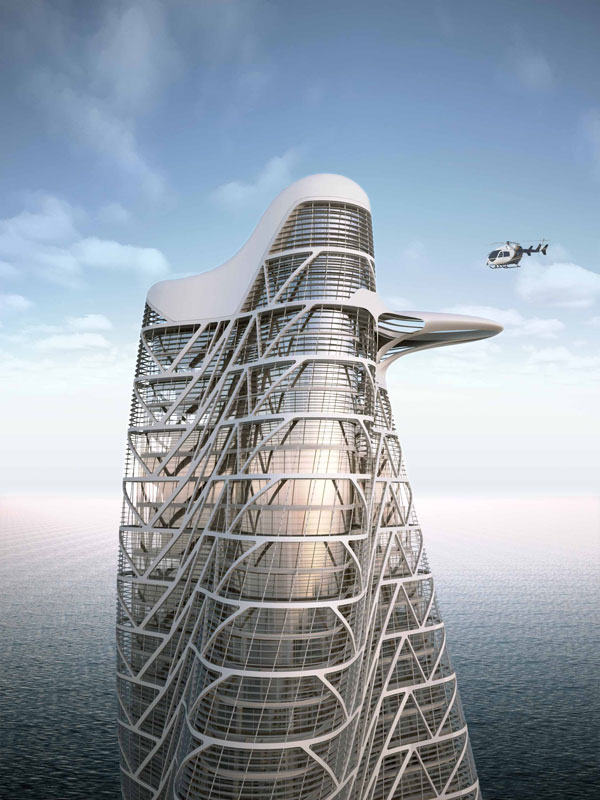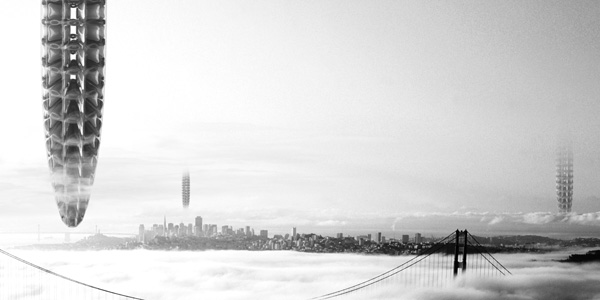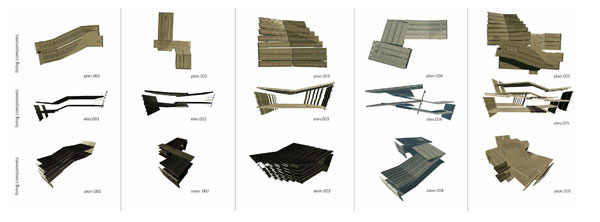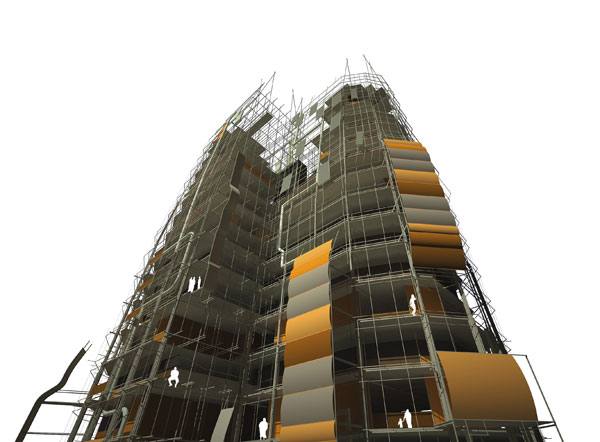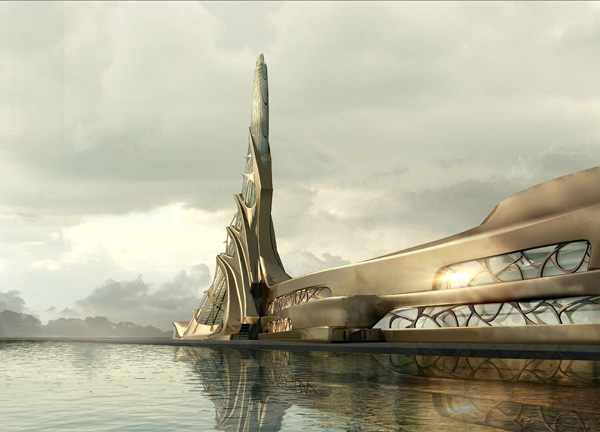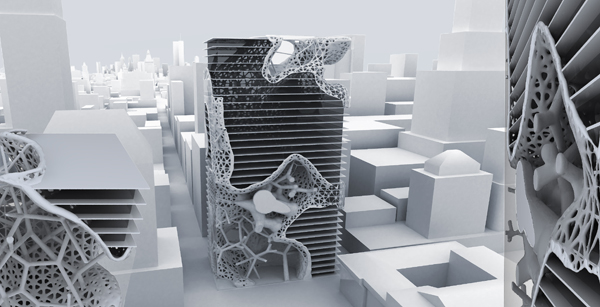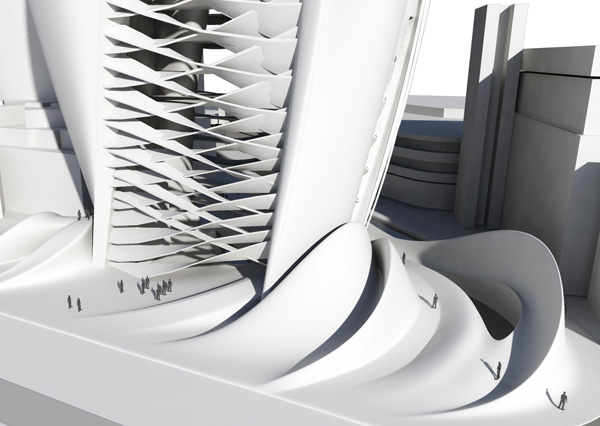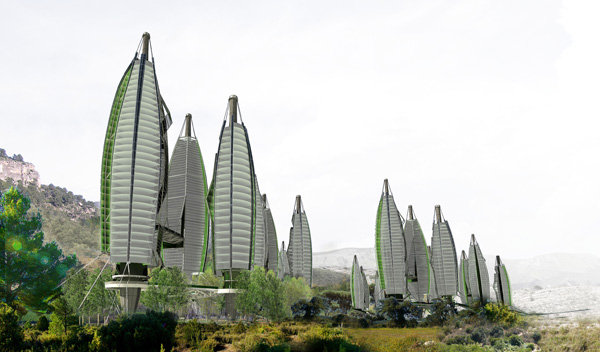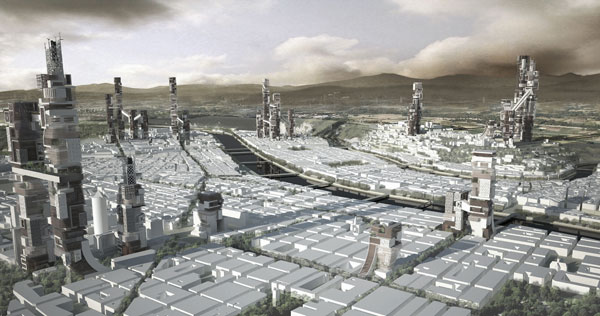Volutes is a skyscraper conceived by Asami Takahashi and Jason Lim located in Singapore’s new marina. Our proposal is to pull upwards the urban fabric and create a helical volume. Public programs are wrapped around a central circulation core while six serpentine structures contain the private spaces. The morphology of the building results from the analysis of 6 control lines sweeping around the central core. The outer skin is linked to the main structure with spokes arranged in a hexagonal configuration.Volutes opens at the street level and closes at the top to allow direct sunlight into the city. Its porous skin maximizes ventilation and regulates the green parks and water reservoirs. Read the rest of this entry »
Serpentine Skyscraper in Singapore’s Marina
Strata Tower in Abu Dhabi, UAE / Asymptote Architecture
The Strata Tower, a forty-story, luxury residential building designed by architects Hani Rashid and Lise Anne Couture of Asymptote, has broken ground on Al Raha Beach and is now under construction. The tower is scheduled for completion in early 2011 and, at a height of 160 meters, will be the tallest building in the Al Dana precinct, the centerpiece of Aldar Properties PJSC’s prestigious Al Raha Beach development. The project and development was showcased at Cityscape Abu Dhabi from May 13–15, 2008. The landmark Strata Tower is designed to signify a dignified and important future for Abu Dhabi and the region.
As a signature architectural statement, the Strata Tower’s articulate, striking physical presence seeks to encapsulate meaning through the use of abstract form drawn from both local cultural landscapes and motifs and dynamic forces of global influence. The Strata Tower’s design utilizes primarily mathematical means in its design to achieve both a poetic, as well as highly pertinent, architecture for the UAE, a region in flux with ambitions for continued rapid growth. Read the rest of this entry »
Space Skyscraper
The main idea behind this proposal is to build a skyscraper in space. It will sit on the plane of an orbit where gravity is zero. The concept is to keep the median point of the structure on the orbital plane and build it until it almost reaches the Earth’s surface. This experiment is one of the many investigations to free the skyscraper from gravity and create the tallest structure which could completely solve our housing problems. The building is 1000 kilometers tall and its orbital plane would be at 500 kilometers. Read the rest of this entry »
Linear City Would Connect San Diego and San Francisco
Architects Joseph Moore and David Tai Wai Pak believe that the future of urban design will be found in the interdependence of expansion and mass transit systems. In California the directionless sprawl of its largest cities has created a culture of cars, pollution and commuting. Continual independent growth was solution that provided great comfort and freedom while land and resources were available. However, California’s population has grown exceedingly in the past fifty years and it cannot sustain its current growth within this old system. Los Angeles’s population in particular has increased from 4.7 million in 1950 to a staggering 16 million in 2008 and it is projected by the U.S. Census Bureau to continue to grow to a total population of 24.6 million by 2050. To deal with this future population increase, Intension proposes to relocate any further expansion of California’s major cities towards a linear urban plan. The catalyst for this proposal was California Department of Transportation’s development of a high speed rail that will link major cities from Sacramento to San Diego. Read the rest of this entry »
Slumdog Superstructure in Nairobi
Kibera in Nairobi, Kenya is Africa’s second largest slum and one of the densest human settlements on the planet; over a million people in a congested mess of cardboard and corrugated tin shanties in a bare two-and-half square kilometers area.
The settlement’s illegality is at the heart of its perverse attraction; chaotic, anarchic – unbound by tenancy laws or building restrictions or any of the strident, stringent limitations of a modern city. The land is cheap, and the slum, with both its proximity to Nairobi and its own, semi-autonomous economy, exercises a magnetic attraction on the millions of Kenyans fleeing rural poverty. Yet the area is dominated by a handful of landlords, who have no incentive to invest in Kibera’s infrastructure. Illegal in the eyes of their government, and ignored by their erstwhile landlords, the residents of the slum make do as best they can; struggling with the – literally – shifting territory, with internecine and inter-ethnic strife, with fire and floods. Read the rest of this entry »
Biomorphic Skyscraper
As time transcends the virtual and physical limits of tall buildings, their ability to mingle into the existing urban fabric and transform a city’s dynamic core becomes a fine line between the density and physical mass already embedded in the metropolis and the ingenious ability to create grandeur. We therefore only see fragments of the past and brave gestures of the future in the densification of urban cores. Each gesticulation becomes an expression – a murmur on the reality of what could be achieved.
To allow for true freedom of expression that allows complete indulgence concerning the interplay of form and structure we have to consider the rationale of building placement. Allowing buildings to set their footprint in avenues of un-built mass provides for urban renewal in areas of cities previously left as urban wasteland from decaying manufacturing. Read the rest of this entry »
Trabeculae: Re-imagining the Office Building
Trabeculae is the result of re-imagining the central atrium office tower. Replacing the traditional operation of repetitive extrusion, a heliotrope branching system actively seeks out those areas within the zoning envelope with greatest access to daylight. Forking and swelling in response to varying light conditions the atrium is thus conceived as a site-specific network that traverses intelligently and freely from one façade to another. The atrium becomes the defining element of differentiation within otherwise normative floor plates while maintaining efficient floor space ratios.
Within the atrium a second order proliferation of the same system at a finer scale develops a structural meshwork. The swellings and coagulations of this topologically free structural network-within-a-network accommodate meeting rooms and bridges.
The ambition of achieving inorganic speciation is part of Supermanoeuvre’s broader research into the capacity of generative architectural methodologies to negotiate novel spatial, formal and material organizations. Whereby, the performance and character of architecture is elaborated through both the internal systemic logics of the algorithm and its motivated response to external stimuli and latent conditions. Read the rest of this entry »
Bioclimatic Tower for Equatorial Climates
Helices Tower conceived by Julia Koerner is a building prototype that aims to transform the modern high-rise typology for equatorial climates through the incorporation of sustainable, bioclimatic building-systems. The design demonstrates that passive ventilation strategies can be exploited for both energy efficiency and formal beauty.
The design features innovative building systems that transition from highly articulated, two-dimensional façade patterns to three-dimensional bioclimatic interior spaces.
Helices Tower consists of two primary elements: opaque monolithic cores, incorporating the ventilation system and primary structural system, and the twisting helices that span in-between to form floor slabs and interior spaces. The cores are located on the east and west sides to shade the building from low solar angles while the helical slabs create a fluid gradient pattern on the façade and provide additional shading for the interior. Read the rest of this entry »
Reforesting Tower in Benidorm, Spain
Benidorm is a Spanish town that enjoys a pleasant semi-arid Mediterranean weather. It attracts thousands of tourists to its pristine waters and beaches. In the last few years it has been affected by unregulated construction that destroyed most of its vegetation with catastrophic consequences. There has been an increase in temperature, reduction of humidity, and long summer droughts. Read the rest of this entry »
Skyscrapers Reconfigure Lyon’s Urban Fabric
Urban Stakes is a new type of skyscraper designed by French architects Laurent Bariat and Yann Magnet for the city of Lyon in France. The first urban planning for this city dates back to the Roman Empire. The second one took place during the Middle Ages and the third one during the industrial revolution. During the last four decades its population has dramatically increased and the urban fabric is rapidly growing with careful consideration of the environment. Read the rest of this entry »

